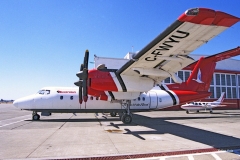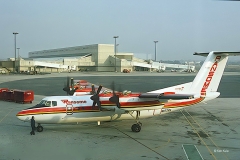
De Havilland Canada designed a niche airliner in the 1970s, which became known as the ” Dash 7″. The DHC-7 was a four-engined turboprop airliner with seating for approximately 50 passengers, give or take a couple depending upon the variant. Instead of relying on speed, the Dash 7 relied on excellent STOL capabilities and less noise (when compared to its competitors like the Fokker 27, Hawker Siddeley 748 and Convair 580/600)to make a business case. Excellent performance at high-altitude airports was another selling point.

The first flight of the Dash 7 prototype took place on March 27, 1975. Development went smoothly, and the first production airliner was delivered to Rocky Mountain Airways in early 1978. Rocky Mountain Airways capitalized on the plane’s STOL capability by delivering skiers to Colorado airports like Telluride and Steamboat Springs. Several specialized Colorado STOL airports were active and used by the Dash 7s too.
Hawaiian Airlines used the Maui, Hawaii Kapalua Airport for their Dash 7 service, the runway was only 3000 feet long, and affected by Hawaii’s warmth year-round.
The London City Airport’s short runway and steep approach angle was easily mastered by Dash 7 operator London City Airways, gaining passenger access to the city in much less time than flights operating to/from Heathrow and Gatwick.

Several variants of the Dash 7 were built, the -103 version was the most-produced passenger airliner A few -110 series were built to British Airworthiness standards, and one -150IR ice reconnaissance version is operated by Bradley Air Services for the Canadian Government. The U.S. Army still uses several EO-5/RC-7B multi-sensor aircraft, and both Canada and Venezuela operated military transport versions too. Altogether, some 113 production airframes and several prototypes (at least 2) were built and delivered.

De Havilland Canada delivered 113 aircraft before selling the design to Boeing, which decided to focus on the Dash 8 twin-turboprop instead. Production of the aircraft ended in 1988. Boeing in turn sold the design to Bombardier, who sold it to current manufacturer Viking Air. The aircraft is out of production.
More than 2 dozen airlines in the U. S. operated Dash 7s. Many were operated by one company for a larger airline, such as Pan Am Express by Ransome Airlines. Here are a handful of photos of Dash 7s over the years.











